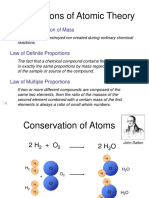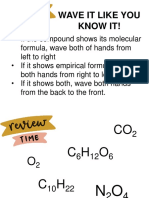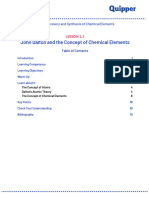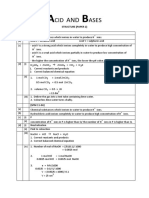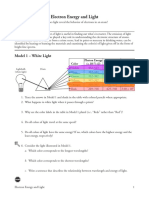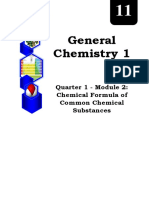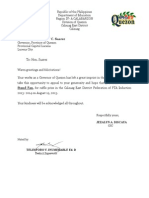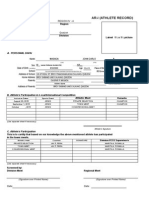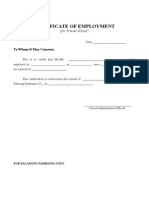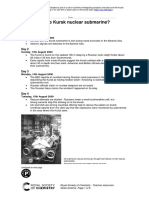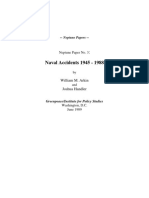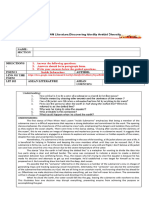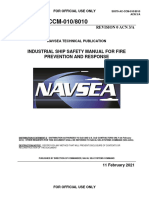Gas Law
Gas Law
Uploaded by
Jensen Ryan LimCopyright:
Available Formats
Gas Law
Gas Law
Uploaded by
Jensen Ryan LimOriginal Description:
Original Title
Copyright
Available Formats
Share this document
Did you find this document useful?
Is this content inappropriate?
Copyright:
Available Formats
Gas Law
Gas Law
Uploaded by
Jensen Ryan LimCopyright:
Available Formats
Name:
Date:
Block:
Gas Laws Practice
Complete ALL problems under each heading in your packer. SHOW ALL WORK AND LABELS!
Bolyes Law Problems
P1V1 = P2V2
Example: If I have 5.6 liters of gas in a piston at a pressure of 1.5 atm and compress the gas until its volume is 4.8 L, what will the new pressure inside the piston be? Read the problem and determine what is given and what is unknown? Decide which law to use. Substitute the values (given numbers) from the problem into the equation Given: P1 = 1.5 atm Unknown or find: P2 = ? = X V1 = 5.6 L V2 = 4.8 L Note: Since this problem involves two pressures and two volumes we will use Boyles law equation to solve it: P1V1 = P2V2 (1.5) (5.6) = X (4.8) Now solve for X 8.4 = 4.8 X 4.8 4.8 1.75 atm = X = P2 The new pressure inside the piston is 1.75 atm.
1. I have added 15 L of air to a balloon at sea level (1.0 atm). If I take the balloon with me to Denver, where the air pressure is 0.85 atm, what will the new volume of the balloon be?
2. Ive got a car with an internal volume of 12,000 L. If I drive my car into the river and it implodes, what will be the volume of the gas when the pressure goes from 1.0 atm to 1.4 atm?
3. 1.0 L of a gas at standard temperature and standard pressure is compressed to 473 mL. What is the new pressure of the gas?
4. In a thermonuclear device, the pressure of 0.050 liters of gas within the bomb casing reaches 4.0 x 106 atm. When the bomb casing is destroyed by the explosion, the gas is released into the atmosphere where it reaches a pressure of 1.00 atm. What is the volume of the gas after the explosion?
Unit 5 Gas Laws Trivedi Page 1 of 6
5. Synthetic diamonds can be manufactured at pressures of 6.00 x 104 atm. If we took 2.00 liters of gas at 1.00 atm and compressed it to a pressure of 6.00 x 104 atm, what would the volume of that gas be?
6. The highest pressure ever produced in a laboratory setting was about 2.0 x 106 atm. If we have a 1.0 x 10-5 liter sample of a gas at that pressure, then release the pressure until it is equal to 0.275 atm, what would the new volume of that gas be?
7. Atmospheric pressure on the peak of Mt. Everest can be as low as 150 mm Hg, which is why climbers need to bring oxygen tanks for the last part of the climb. If the climbers carry 10.0 liter tanks with an internal gas pressure of 3.04 x 104 mm Hg, what will be the volume of the gas when it is released from the tanks? (hint: convert pressure into atm)
8. While using explosives to knock down a building, the shock wave can be so strong that 12 liters of gas will reach a pressure of 3.8 x 104 mm Hg. When the shock wave passes and the gas returns to a pressure of 760 mm Hg, what will the volume of that gas be? (hint: convert pressure into atm)
9. An experimental research submarine with a volume of 15,000 liters has an internal pressure of 1.2 atm. If the pressure of the ocean breaks the submarine forming a bubble with a pressure of 250 atm pushing on it, how big will that bubble be?
10. Divers get the bends if they come up too fast because gas in their blood expands, forming bubbles in their blood. If a diver has 0.05 L of gas in his blood under a pressure of 250 atm, then rises instantaneously to a depth where his blood has a pressure of 50.0 atm, what will the volume of gas in his blood be? Do you think this will harm the diver?
Answers: 1) 1.75 L 2) 8571.42L 3) 2.11 atm 4) 2.0 x 105 L 5) 3.33 x 10-5 L 6) 72.7 L 7) 2.0 x 103 L 8) 600 L 9) 72 L 10) 0.25 L, yes
Unit 5 Gas Laws
Trivedi
Page 2 of 6
Charles Law Problems
V1 = V2 T1 T2
Example: If I have 45 liters of helium in a balloon at 250 C and increase the temperature of the balloon to 550 C, what will the new volume of the balloon be? Read the problem and determine what is given and what is unknown? (Convert temperature into Kelvin) Decide which law to use. Substitute the values (given numbers) from the problem into the equation Given: V1 = 45 L T1 = 25 oC = 25 + 273 = 298 k T2 = 55oC = 55 + 273 = 328 k V2 = ? = X Note: Since this problem involves two volumes and two temperatures we will use Charles law equation to solve it: V1 = V2 T1 T2 45 = X 298 328 Now cross multiply divide to find X (45) (328) = 298 X 298 298 49.53 L = X = T2 The new volume of the balloon is 49.53 L
1. Calcium carbonate decomposes at 12000 C to form carbon dioxide and calcium oxide. If 25 liters of carbon dioxide are collected at 12000 C, what will the volume of this gas be after it cools to 250 C?
2. I have 130 liters of gas in a piston at a temperature of 2500 C. If I cool the gas until the volume decreases to 85 liters, what will temperature of the gas be?
3. The temperature inside my refrigerator is about 40 Celsius. If I place a balloon in my fridge that initially has a temperature of 220 C and a volume of 0.5 liters, what will be the volume of the balloon when it is fully cooled by my refrigerator?
Unit 5 Gas Laws
Trivedi
Page 3 of 6
4. A man heats a balloon in the oven. If the balloon initially has a volume of 0.4 liters and a temperature of 20 0C, what will the volume of the balloon be after he heats it to a temperature of 250 0C?
5. On hot days, you may have noticed that potato chip bags seem to inflate, even though they have not been opened. If I have a 250 mL bag at a temperature of 19 0C, and I leave it in my car which has a temperature of 600 C, what will the new volume of the bag be?
6. A soda bottle is flexible enough that the volume of the bottle can change even without opening it. If you have an empty soda bottle (volume of 2 L) at room temperature (25 0C), what will the new volume be if you put it in your freezer (-4 0C)?
7. Some students believe that teachers are full of hot air. If I inhale 2.2 liters of gas at a temperature of 180 C and it heats to a temperature of 380 C in my lungs, what is the new volume of the gas?
8. How hot will a 2.3 L balloon have to get to expand to a volume of 400 L? Assume that the initial temperature of the balloon is 25 0C.
9. I have made a thermometer that measures temperature by the compressing and expanding of gas in a piston. I have measured that at 1000 C the volume of the piston is 20 L. What is the temperature outside if the piston has a volume of 15 L? What would be appropriate clothing for the weather?
10. 100 ml of a gas is collected at a temperature of 25 deg C. What would be the volume of the gas at standard temperature?
Answers: 1) 5.05 L 2) 342 K 3) 0.47 L 4) 0.71 L 5) 0.285L or 285 mL 6) 1.81 L 7) 2.35 L 8) 51,826 K 9) The temperature is 280 K, which corresponds to 70 C. A jacket would be appropriate clothing for this weather. 10) 0.091L or 91.61
Unit 5 Gas Laws
Trivedi
Page 4 of 6
Combined Gas Law Problems
P1V1 = P2V2 T1 T2
Example: A toy balloon has an internal pressure of 1.05 atm and a volume of 5.0 L. If the temperature where the balloon is released is 200 C, what will happen to the volume when the balloon rises to an altitude where the pressure is 0.65 atm and the temperature is 150 C? Read the problem and determine the given and the unknown variables? (Convert temperature into Kelvin if necessary) Decide which law to use. Substitute the values (given numbers) from the problem into the equation Given: P1 = 1.05 atm V1 = 5.0 L T1 = 20 o C = 20 + 273 = 293 k P2 = 0.65 atm T2 = -15oC = -15 + 273 = 258 k V2 = ? = X Note: Since this problem involves two pressures, two volumes and two temperatures we will use Combined Gas law equation to solve it: P1V1 = P2V2 T1 T2 (1.05) (5) = (0.65) X 293 258 Now cross multiply divide to find X (1.05) (5) (258) = 0.65 X (293) (0.65) 0.65 7.11 L = X = V2 The volume of the balloon will increase to 7.11L
1. A small research submarine with a volume of 1.2 x 105 L has an internal pressure of 1.0 atm and an internal temperature of 150 C. If the submarine descends to a depth where the pressure is 150 atm and the temperature is 30 C, what will the volume of the gas inside be if the hull of the submarine breaks?
2. People who are angry sometimes say that they feel as if theyll explode. If a calm person with a lung capacity of 3.5 liters and a body temperature of 360 C gets angry, what will the volume of the persons lungs be if their temperature rises to 390 C. Based on this, do you think its likely they will explode?
Unit 5 Gas Laws
Trivedi
Page 5 of 6
3. If I initially have a gas at a pressure of 12 atm, a volume of 23 liters, and a temperature of 200 K, and then I raise the pressure to 14 atm and increase the temperature to 300 K, what is the new volume of the gas?
4. A gas takes up a volume of 17 liters, has a pressure of 2.3 atm, and a temperature of 299 K. If I raise the temperature to 350 K and lower the pressure to 1.5 atm, what is the new volume of the gas?
5. A gas that has a volume of 28 liters, a temperature of 45 0C, and an unknown pressure has its volume increased to 34 liters and its temperature decreased to 35 0C. If I measure the pressure after the change to be 2.0 atm, what was the original pressure of the gas?
6. A gas has a temperature of 14 0C, and a volume of 4.5 liters. If the temperature is raised to 29 0C and the pressure is not changed, what is the new volume of the gas?
7. If I have 17 liters of gas at a temperature of 67 0C and a pressure of 88.89 atm, what will be the pressure of the gas if I raise the temperature to 94 0C and decrease the volume to 12 liters?
8. I have an unknown volume of gas at a pressure of 0.5 atm and a temperature of 325 K. If I raise the pressure to 1.2 atm, decrease the temperature to 320 K, and measure the final volume to be 48 liters, what was the initial volume of the gas?
9. If I have 21 liters of gas held at a pressure of 78 atm and a temperature of 900 K, what will be the volume of the gas if I decrease the pressure to 45 atm and decrease the temperature to 750 K?
10. If I have 2.9 L of gas at a pressure of 5 atm and a temperature of 50 0C, what will be the temperature of the gas if I decrease the volume of the gas to 2.4 L and decrease the pressure to 3 atm?
Answers :1) 767 L 2) 3.53 L it seems unlikely that this very small increase in lung volume would cause somebody to explode, though you never know 3) 29.36 L 4) 30.5 L 5) 2.51 atm 6) 4.74 L 7) 136 atm 8) 117 L 9) 30.3 L 10) 160 K
Unit 5 Gas Laws
Trivedi
Page 6 of 6
You might also like
- Silent Hunter 5 Instruction Manual (English)Document35 pagesSilent Hunter 5 Instruction Manual (English)jaywit56% (9)
- Universal Sound Effects LibraryDocument25 pagesUniversal Sound Effects Librarynikos.karakalosNo ratings yet
- CH 11 Liquids, Solids and Intermolecular Forces StudentDocument113 pagesCH 11 Liquids, Solids and Intermolecular Forces StudentAneeqa YounasNo ratings yet
- Rates of ReactionDocument10 pagesRates of ReactionAlex noslenNo ratings yet
- Worksheet - Limiting and Excess Problems - VuDocument2 pagesWorksheet - Limiting and Excess Problems - VuMARIONNE CALIMLIM100% (1)
- (Q1) MODULE 10 - Gas Stoichiometry PDFDocument18 pages(Q1) MODULE 10 - Gas Stoichiometry PDFJewel SantiagoNo ratings yet
- PropertiesDocument41 pagesPropertiesMarielle LabradoresNo ratings yet
- S9MT-II-c-d-15 Properties of Metals in Terms of Structurelp2nd QuarterDocument5 pagesS9MT-II-c-d-15 Properties of Metals in Terms of Structurelp2nd QuarterJoy ValdezNo ratings yet
- Ideal Gas Law ProblemsDocument7 pagesIdeal Gas Law ProblemsJamie Nguyen0% (1)
- Naming Ionic CompoundsDocument6 pagesNaming Ionic CompoundsMary Jane YepesNo ratings yet
- Describe How Fossil Fuels Are Formed GROUP2Document10 pagesDescribe How Fossil Fuels Are Formed GROUP2Zyron Pancho100% (1)
- Ionic Covalent LABDocument3 pagesIonic Covalent LABPriyasree KarunanethiNo ratings yet
- Polar Bonds and Polar MoleculesDocument20 pagesPolar Bonds and Polar MoleculesLYNFORD LAGONDINo ratings yet
- Dalton Model of The AtomDocument10 pagesDalton Model of The AtomLilo TolentinoNo ratings yet
- Distillation of Binary LiquidsDocument29 pagesDistillation of Binary LiquidsJan Lloyd ProbitsoNo ratings yet
- Chemical ReactionDocument30 pagesChemical ReactionAnna Liza GomezNo ratings yet
- GENERAL CHEMISTRY - Q1 - Mod8 - Write and Balance Chemical EquationDocument13 pagesGENERAL CHEMISTRY - Q1 - Mod8 - Write and Balance Chemical EquationLU NANo ratings yet
- Module 1 - General Chemistry 1 (Final)Document7 pagesModule 1 - General Chemistry 1 (Final)Mutsumi JingujiNo ratings yet
- Topic 5 - 'Stoichiometry'Document28 pagesTopic 5 - 'Stoichiometry'Nayeem HakimNo ratings yet
- Lesson 6 Limiting ReactantsDocument23 pagesLesson 6 Limiting ReactantsJabeguero Marvelyn Jessica100% (1)
- Chapter 12 Properties of Solutions Dr. DDocument36 pagesChapter 12 Properties of Solutions Dr. DRoseman TumaliuanNo ratings yet
- Acids, Bases and SaltsDocument6 pagesAcids, Bases and SaltsPranav ShindeNo ratings yet
- Matter and Its PropertiesDocument3 pagesMatter and Its PropertiesCynthia100% (1)
- Heating and Cooling Curve of A SubstanceDocument62 pagesHeating and Cooling Curve of A SubstanceIan Alfred Brimbuela100% (2)
- Classification Tests For Hydrocarbons Formal Report PDF FreeDocument5 pagesClassification Tests For Hydrocarbons Formal Report PDF FreeWavingOceansNo ratings yet
- Rates of Reactions PDFDocument18 pagesRates of Reactions PDFLin Xian XingNo ratings yet
- Chemical Formula: Self Learning Module College/Department: Course Code: Chem 1 Course Title: General Chemistry TopicDocument7 pagesChemical Formula: Self Learning Module College/Department: Course Code: Chem 1 Course Title: General Chemistry TopicLorielle OlivaNo ratings yet
- Law of Multiple ProportionsDocument6 pagesLaw of Multiple ProportionsHelmut SoehnNo ratings yet
- 1stQ.3.5 Chemical Formulas Naming WritingDocument41 pages1stQ.3.5 Chemical Formulas Naming WritingRaiden Gabriel LontokNo ratings yet
- Worksheet - Law of Conservation of MassDocument3 pagesWorksheet - Law of Conservation of MassniaNo ratings yet
- Ideal Gas: General Chemistry 1Document9 pagesIdeal Gas: General Chemistry 1Daniel Corcino100% (1)
- 11 Polar and NonPolar MoleculesDocument2 pages11 Polar and NonPolar Moleculesmohamed ismail100% (1)
- Educational PsychologyDocument29 pagesEducational Psychologydrsaimamuneer.ierNo ratings yet
- Week 5 - John Dalton and The Concept of Chemical Elements - 0Document14 pagesWeek 5 - John Dalton and The Concept of Chemical Elements - 0yourarmoristakenNo ratings yet
- Atoms and The Mole (Pre-AP)Document13 pagesAtoms and The Mole (Pre-AP)ddhhdhdhdNo ratings yet
- Formation & Structure of PolymersDocument6 pagesFormation & Structure of PolymersBensonjr Magaway De OcampoNo ratings yet
- Mole FractionDocument13 pagesMole FractionKim CarsonNo ratings yet
- Lesson 3 Exo and EndoDocument7 pagesLesson 3 Exo and Endoapi-385539760No ratings yet
- Gas Stoichiometry WSDocument2 pagesGas Stoichiometry WSRogerine RoyNo ratings yet
- Lecture 1 Introduction To SolubilityDocument47 pagesLecture 1 Introduction To SolubilityshiraNo ratings yet
- Solutions and ConcentrationDocument18 pagesSolutions and Concentrationapi-483662721100% (1)
- Polar Bonds and Polar MoleculesDocument21 pagesPolar Bonds and Polar MoleculesShhhhhhhhyeahNo ratings yet
- Lesson Plan: Lesson: Carboxylic Acids (II)Document3 pagesLesson Plan: Lesson: Carboxylic Acids (II)MarcTnnNo ratings yet
- Answer Chemquest18 Acid BasesDocument5 pagesAnswer Chemquest18 Acid BasesazrifNo ratings yet
- Naming CompoundsDocument27 pagesNaming CompoundsAtulya BharadwajNo ratings yet
- Physical and Chemical Changes Lab Pre-Lab DiscussionDocument4 pagesPhysical and Chemical Changes Lab Pre-Lab DiscussionDenver Monico MoscosoNo ratings yet
- Polar and Non PolarDocument16 pagesPolar and Non PolarTherese Anne CababarrosNo ratings yet
- DLL CW - Week 4 Q1Document3 pagesDLL CW - Week 4 Q1JessieMangaboNo ratings yet
- Worksheet - Intermol ForcesDocument5 pagesWorksheet - Intermol Forcesjas02h1No ratings yet
- Physical SCience Lesson 4 The Structure and Properties of MatterDocument9 pagesPhysical SCience Lesson 4 The Structure and Properties of MatterJustin BirdNo ratings yet
- CABAL GenChem1Q1 DescartesDocument35 pagesCABAL GenChem1Q1 DescartesRhodel CabalNo ratings yet
- Chapter 2 PowerPointDocument38 pagesChapter 2 PowerPointpopadora100% (1)
- Lewis Dot DiagramDocument3 pagesLewis Dot DiagramAlexa SokolovicNo ratings yet
- 12 Electron Energy and Light-SDocument6 pages12 Electron Energy and Light-SSelma CedilloNo ratings yet
- Activity 6 Equilibrium and Le Chatelier - S PrincipleDocument10 pagesActivity 6 Equilibrium and Le Chatelier - S PrinciplekentbrianbonbonNo ratings yet
- 6 4IonizEnergyDocument1 page6 4IonizEnergyShehbaz YaseenNo ratings yet
- Intermolecular ForcesDocument24 pagesIntermolecular ForcesEvangelene Esquillo SanaNo ratings yet
- GENERAL CHEMISTRY - Q1 - Mod2 - Chemical Formula of Common Chemical SubstancesDocument14 pagesGENERAL CHEMISTRY - Q1 - Mod2 - Chemical Formula of Common Chemical SubstancesRieck PacoNo ratings yet
- 3 CHANG Mass Relationships in Chemical Reactions PPT - ppt3cDocument32 pages3 CHANG Mass Relationships in Chemical Reactions PPT - ppt3cJoseKenwan100% (3)
- Yvonne - Empirical and Molecular FormulaDocument11 pagesYvonne - Empirical and Molecular FormulaYvonne ZafraNo ratings yet
- Gas Laws PracticeDocument3 pagesGas Laws Practiceapi-280439402No ratings yet
- All Gas LawDocument5 pagesAll Gas LawdasaNo ratings yet
- "Saved Successfully" "" "" "" "" "" "" "" "" "": EventargsDocument2 pages"Saved Successfully" "" "" "" "" "" "" "" "" "": EventargsJensen Ryan LimNo ratings yet
- Different Parts of A Research PaperDocument2 pagesDifferent Parts of A Research PaperLewy Katrin S. CortezNo ratings yet
- Tan LetterDocument1 pageTan LetterJensen Ryan LimNo ratings yet
- Omnibus Sworn CertiDocument2 pagesOmnibus Sworn CertiJensen Ryan LimNo ratings yet
- Solve For The Value of XDocument1 pageSolve For The Value of XJensen Ryan LimNo ratings yet
- C E D P T E A: Alauag Ast Istrict Ublic School Eachers and Mployees SsociationDocument1 pageC E D P T E A: Alauag Ast Istrict Ublic School Eachers and Mployees SsociationJensen Ryan LimNo ratings yet
- Calauag Montessori Learning Center Foundation, Inc.: Secondary Student'S Permanent RecordDocument6 pagesCalauag Montessori Learning Center Foundation, Inc.: Secondary Student'S Permanent RecordJensen Ryan LimNo ratings yet
- Calauag Montessori Learning Center Foundation, Inc.: Secondary Student'S Permanent RecordDocument6 pagesCalauag Montessori Learning Center Foundation, Inc.: Secondary Student'S Permanent RecordJensen Ryan LimNo ratings yet
- John Leaves School To Go HomeDocument1 pageJohn Leaves School To Go HomeJensen Ryan LimNo ratings yet
- A Man On A 135Document2 pagesA Man On A 135Jensen Ryan LimNo ratings yet
- Jensen Ryan T. LimDocument1 pageJensen Ryan T. LimJensen Ryan LimNo ratings yet
- Oath Taking CeremonyDocument3 pagesOath Taking CeremonyJensen Ryan Lim100% (10)
- HEKASIDocument24 pagesHEKASIJensen Ryan LimNo ratings yet
- Joint Meeting of TeachersDocument2 pagesJoint Meeting of TeachersJensen Ryan LimNo ratings yet
- Production Number: Rating Scale: 5 Is Lowest 10 Is HighestDocument42 pagesProduction Number: Rating Scale: 5 Is Lowest 10 Is HighestJensen Ryan LimNo ratings yet
- Japanese TranslationDocument9 pagesJapanese TranslationJensen Ryan LimNo ratings yet
- Letter To PnuDocument1 pageLetter To PnuJensen Ryan LimNo ratings yet
- HON. David "Jay Jay" C. SuarezDocument1 pageHON. David "Jay Jay" C. SuarezJensen Ryan LimNo ratings yet
- Hekasi Calendar F ActivitiesDocument8 pagesHekasi Calendar F ActivitiesJensen Ryan LimNo ratings yet
- Ar-I (Athlete Record) : RegionDocument6 pagesAr-I (Athlete Record) : RegionJensen Ryan LimNo ratings yet
- Cerificate of Employment For Private SchoolsDocument1 pageCerificate of Employment For Private SchoolsJensen Ryan LimNo ratings yet
- Ar-I (Athlete Record) : RegionDocument6 pagesAr-I (Athlete Record) : RegionJensen Ryan LimNo ratings yet
- Propaganda and CharicatureDocument31 pagesPropaganda and Charicaturenela1945No ratings yet
- DCNS Press KitDocument67 pagesDCNS Press Kitlistener9983No ratings yet
- What Sank The Kursk Nuclear Submarine?: News TimelineDocument6 pagesWhat Sank The Kursk Nuclear Submarine?: News TimelineEddy Richards100% (1)
- How We Would Fight China - Robert D. KaplanDocument13 pagesHow We Would Fight China - Robert D. Kaplancarlosnestor100% (1)
- WWII Civil Air Patrol U-Boat StoryDocument8 pagesWWII Civil Air Patrol U-Boat StoryCAP History LibraryNo ratings yet
- Tsunami ProjectDocument61 pagesTsunami ProjectRaj Paulam GandhiNo ratings yet
- AINTSSA's Memorandum To 7th CPCDocument130 pagesAINTSSA's Memorandum To 7th CPCStaff_Corner100% (1)
- USNTMJ Table of ContentsDocument6 pagesUSNTMJ Table of ContentsMichal RosaNo ratings yet
- Development of The Stirling AIP SystemDocument37 pagesDevelopment of The Stirling AIP SystemAhmad SafrizalNo ratings yet
- USW Summer 2018Document17 pagesUSW Summer 2018MALAI CiprianNo ratings yet
- Ship Concealment and Camoflage Instructions 1953Document89 pagesShip Concealment and Camoflage Instructions 1953stacktranzerNo ratings yet
- NavalAccidents1945 1988Document86 pagesNavalAccidents1945 1988fedmarsNo ratings yet
- 23rd ATTCDocument389 pages23rd ATTCdushan diasNo ratings yet
- SSN-21 Seawolf - Quick Reference Card - PCDocument21 pagesSSN-21 Seawolf - Quick Reference Card - PCMarvin Mclendon100% (1)
- USSBS, Summary Report, European and Pacific WarDocument126 pagesUSSBS, Summary Report, European and Pacific WarJapanAirRaids100% (1)
- Inside SubmarinesDocument2 pagesInside SubmarinesVhien Paulo Navarro0% (1)
- J-11 8010 Manual ACN-3-ADocument198 pagesJ-11 8010 Manual ACN-3-Achou youNo ratings yet
- Final EssayDocument4 pagesFinal Essayamarah200481No ratings yet
- EE 1918 DecDocument84 pagesEE 1918 DecJim ToewsNo ratings yet
- Submarine Propulsion SystemsDocument3 pagesSubmarine Propulsion SystemshellboyNo ratings yet
- VISBY Class Stealth CorvetteDocument20 pagesVISBY Class Stealth Corvetteمحمد على100% (1)
- XGuide For U-Boat Officers Concerning New U-Boat Orders For The FrontlineDocument65 pagesXGuide For U-Boat Officers Concerning New U-Boat Orders For The FrontlineDongelx100% (1)
- Naval RulesDocument21 pagesNaval Rulesmogator100% (2)
- Naval Handling Systems: + Products + Capabilities + SolutionsDocument16 pagesNaval Handling Systems: + Products + Capabilities + SolutionsAytaç KesginNo ratings yet
- Official Naval Dispatches No. 3 1914Document44 pagesOfficial Naval Dispatches No. 3 1914Sean CampbellNo ratings yet
- A Brief History of Active SonarDocument9 pagesA Brief History of Active SonarNGUYEN VINH VINHNo ratings yet
- Improving Submarine Array IntegrationDocument8 pagesImproving Submarine Array IntegrationshahpinkalNo ratings yet
- TS9090-310D CHG-2 V2Document124 pagesTS9090-310D CHG-2 V2qualiman1No ratings yet













